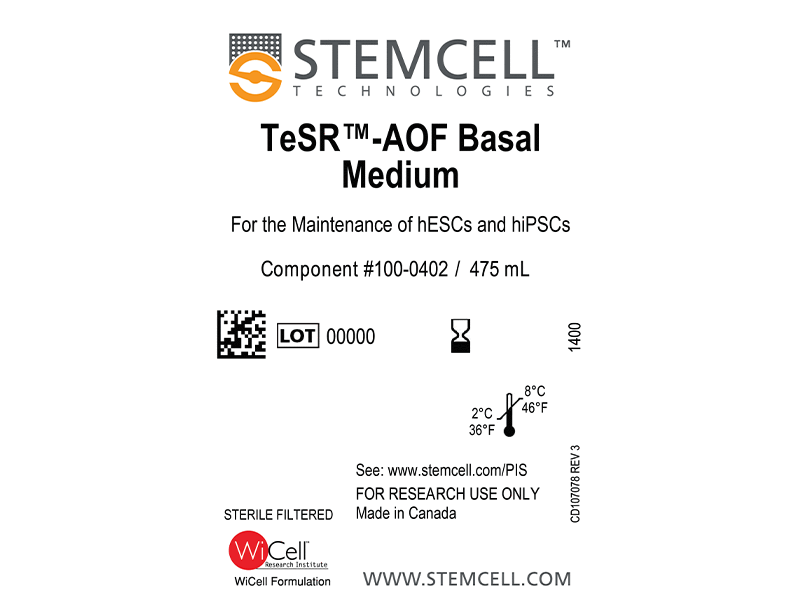STEMCELL Technologies TeSR TeSR-AOF
- 研究用
TeSR™-AOFは、ヒト胚性幹(ES)および人工多能性幹(iPS)細胞をフィーダーフリー培養で維持および増殖する、動物由来フリー(animal origin-free; AOF)の安定化された無血清培地です。培地組成は、ヒトES/iPS細胞用フィーダーフリー培地のうち論文発表数が最多であるTeSR™(Ludwig TE et al. 2006)に基づいています。
特に制限された栄養補給の間、細胞の品質を高めるために、線維芽細胞成長因子2(FGF2;塩基性FGF [bFGF]としても知られている)を含む重要な培地成分が安定化されています。その結果、TeSR™-AOFは毎日または制限された給餌のスケジュールに適合し、どちらの条件下でも細胞の品質とパフォーマンスを同等に維持できます。
TeSR™-AOFは、Corning® Matrigel® hESC-Qualified Matrix (Corning Catalog #354277)、VitronectinXF™(ST-07180)、Biolaminin 521 MX(BLA-MX521-0501)、Biolaminin 521 CTG(BLA-CT521-0501)など、さまざまな培養マトリックスに適合します。
本品とその構成要素の製造には、少なくとも二次的な製造レベルまで、動物またはヒト由来の材料は使用されていません。このため、製造の一次レベルのみで動物由来フリーの培地と比較して、トレーサビリティとウイルス安全性がより強化されております。TeSR™-AOF完全培地の調製に使用する TeSR™-AOF 20X Supplementの各ロットは、ヒト多能性幹細胞を使用した培養アッセイで性能試験されています。
本品はcGMPのもとで製造され、再現性の高い結果を保証するために最高の品質と一貫性を備えています。
製品の特長
TeSR™-AOFで、ヒト多能性幹細胞を動物由来フリーかつフィーダーフリーの安定化条件で維持培養
- 動物由来フリー
製造の二次レベルまで動物原料を含まない培地を選択することにより、補助材料選択におけるリスクを軽減 - 一貫した細胞増殖
高品質のコロニー形態、安定した細胞接着、および細胞増殖をサポート - 安定化された培地組成
FGF2を含む安定化された成分が、高い細胞品質を維持したまま給餌スケジュールの変更を可能に
データ紹介
制限された栄養補給スケジュールの下でも、hPSCの品質と増殖速度を維持します
Figure 1A. hPSCs Maintained in TeSR™-AOF with Daily and Restricted Feed Schedules Exhibit Comparable Colony Morphology
hPSCs were maintained on Vitronectin XF™ for five passages. Phase-contrast images were taken on day 7 after seeding. For restricted feeds, hPSCs were fed with a double volume (4 mL) of medium on day 2 after passage, followed by two consecutive skipped days of feeds, with a final single-volume feed (2 mL) on day 5, prior to passaging on day 6 or 7.
Figure 1B. hPSCs Maintained in TeSR™-AOF with Daily and Restricted Feed Schedules have Comparable Expansion Rates
hPSCs were maintained on Vitronectin XF™ for five passages. At the end of each passage cell counts were obtained using the Nucleocounter® NC-200 ChemoMetec automated cell counter to count DAPI-stained nuclei. The log2 transformed cumulative fold expansion was plotted against time in culture (days).
37℃での培養中、培地成分は長時間にわたり安定しています
Figure 2. Native bFGF Levels are Stabilized at 37°C in TeSR™-AOF
TeSR™-AOF and TeSR™-E8™ were incubated at 37°C for 24, 48, and 72 hours. FGF2 levels were measured by Meso Scale Discovery (MSD) immunoassay; data was normalized to t = 0 levels for TeSR™-E8™ and TeSR™-AOF, respectively. FGF2 levels in TeSR™-AOF remain at 36.7 ± 5.61% of t = 0 levels at 72 hours when incubated at 37°C. Data representative of n = 3 biological replicates ± SD.
制限給餌で培養中も、hPSCのコロニー形態は維持されます
Figure 3. hPSCs Cultured in TeSR™-AOF with Restricted Feeding Maintain Demonstrate Classic hPSC Colony Morphology
hPSCs maintained in TeSR™-AOF were passaged as aggregates with ReLeSR™ passaging reagent every 6-7 days for greater than 10 passages. hPSCs maintained in TeSR™-AOF exhibit hPSC-like morphology, forming densely packed, round colonies with smooth edge morphology. Homogeneous cell morphology characteristic of hPSCs are observed, including large nucleoli and scant cytoplasm.
低タンパク条件下でのhPSCの接着と増殖が改善されます
Figure 4. hPSCs Maintained in TeSR™-AOF Have Improved Attachment and Higher Overall Expansion Compared to Low-Protein Medium
(A) hPSCs cultured in TeSR™-AOF demonstrate a higher plating efficiency compared to hPSCs maintained in low-protein medium (TeSR™-E8™). Plating efficiency is calculated by seeding a known number of aggregates and comparing to the number of established colonies on day 7. (B) hPSCs maintained in TeSR™-AOF exhibit a higher average fold expansion per passage compared to TeSR™-E8™. (C) hPSCs cultured in TeSR™-AOF demonstrate consistent expansion and minimal cell line-to-cell-line variability between ES and iPS cell lines assessed. Cumulative fold expansion was measured from passage 1 to 5. Data represented as mean plating efficiency or fold expansion across 10 passages ± SD. MG = Matrigel®; VN = Vitronectin XF™.
制限給餌で培養したhPSCは、正常な核型を保持しています
Figure 5. hPSCs Cultured in TeSR™-AOF with Restricted Feeding Maintain a Normal Karyotype
ES (H9 & H1) and iPS (STiPS-M001 & STiPS-F016) cell lines cultured in TeSR™-AOF were screened for chromosomal abnormalities using the hPSC Genetic Analysis Kit and by G-banding at ≥ 10 passages. Representative data are shown for (A) H1 ES and STiPS-F016 hiPS cell cultures at passage 10; no common chromosomal abnormalities were detected using the hPSC Genetic Analysis Kit, and (B) H1 ES cultures; these displayed a normal karyotype by G-banding at passage 11 and 13 respectively.
hPSCは未分化マーカーを発現し、3胚葉に分化することができます
Figure 6. hPSCs Cultured in TeSR™-AOF Express Markers of the Undifferentiated State and Differentiate to the Three Germ Layers
(A) hPSCs maintained in TeSR™-AOF exhibit high levels of TRA-1-60 and OCT4 by flow cytometry at passage 5 and 10. Across n = 5 cell lines, the average TRA-1-60 expression was 92.8 ± 3.77 %, and percent OCT-4 positive cells were 98.1 ± 1.79%. Data shown represent an average of passage 5 and 10 flow results for each cell line. MG = Matrigel®; VN = Vitronectin XF™. (B) Efficient differentiation to the three germ layers was demonstrated in one hES and one hiPS cell line maintained for > 5 passages in TeSR™-AOF. Cultures were processed for flow cytometry and assessed for CXCR4+/SOX17+ cells on day 5 following differentiation using the STEMdiff™ Definitive Endoderm Kit. Cultures were processed for flow cytometry and assessed for Brachyury (T)+/OCT4- cells on day 5 following differentiation in STEMdiff™ Mesoderm Induction Medium. Cultures were processed for flow cytometry and assessed for PAX6+/Nestin+ cells on day 7 following monolayer differentiation using STEMdiff™ Neural Induction Medium.
hPSCは、心筋細胞に効率良く分化できます
Figure 7. hPSCs Culture in TeSR™-AOF Differentiate to Cardiomyocytes with the STEMdiff™ Cardiomyocyte Differentiation Kit
Efficient differentiation to cardiomyocytes was demonstrated in 1 hES and 1 hiPS cell line maintained in TeSR™-AOF using the STEMdiff™ Cardiomyocyte Differentiation Kit. Expression of cardiac troponin T (cTnT) was assessed by immunocytochemistry (ICC) and by flow cytometry.
データは、以下リンクでもご覧ください。
動画のご紹介
ヒト多能性幹細胞(hPSC)の生物学の概要、hPSCの品質と特性を評価する方法、プレートコーティング、培地の選択肢、継代から凍結保存までhPSC培養を維持する方法を動画で紹介
(動画の視聴にはSTEMCELL Technologies社ウェブサイトにて登録が必要です)



















